| |
LEGEND:
 |
 |
|
Link to a PDF document |
 |
 |
|
Link to non-governmental site and does not
necessarily represent the views of the CDC |

|
 |
| Adobe
Acrobat (TM) Reader needs to be installed on
your computer in order to read documents in PDF format.
Download the Reader.
|
|
 |
 |
 |

| 
|
Pediatrics
HIV/AIDS Surveillance (through
2006) |
 |
 |
|
Instructions for downloading and using
HIV/AIDS surveillance slides. Download the
complete slide set:
While the content is in the public domain and
no copyright restriction applies,
we do ask that users preserve the slides in
their current format and cite CDC as the
source.
|

Slide 1
Proportion of Perinatally Acquired AIDS Cases by Mother's Transmission Category and Year of Diagnosis 1981–2006—United States and Dependent Areas
PDF
File
 or
PPT
File or
PPT
File |
|
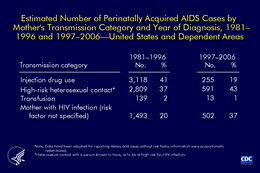
Slide 2
Estimated Number of Perinatally
Acquired AIDS Cases by Mother's
Transmission Category and Year of
Diagnosis 1981–1996 and 1997–2006—United
States and Dependent Areas
PDF
File
 or
PPT
File
or
PPT
File |
|

Slide 3
Reported AIDS Cases in Children <13 Years of Age by Transmission Category, 2006 and Cumulative United States and Dependent Areas
PDF
File
 or
PPT
File or
PPT
File |
|

Slide 4
Estimated Number of Perinatally Acquired AIDS Cases by Year of Diagnosis, 1985–2006 —United States and Dependent Areas
PDF
File
 or
PPT
File or
PPT
File |
|

Slide 5
Zidovudine Use for HIV-infected Pregnant Women or for Perinatally Exposed or Infected Children Born 1993–2006—50 Areas
PDF
File
 or
PPT
File or
PPT
File |
|

Slide 6
Reported AIDS Cases in Children <13 Years of Age at Diagnosis, 2006—United States and Dependent Areas N=86
PDF
File
 or
PPT
File or
PPT
File |
|
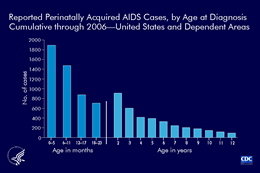
Slide 7
Reported Perinatally Acquired AIDS Cases, by Age at Diagnosis, Cumulative through 2006—United States and Dependent Areas
PDF
File
 or
PPT
File or
PPT
File |
|
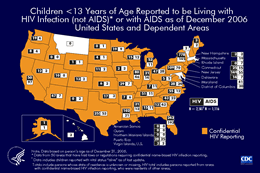
Slide 8
Children <13 Years of Age Reported to be Living with HIV Infection (not AIDS) or with AIDS, Cumulative through 2006—United States and Dependent Areas
PDF
File
 or
PPT
File
or
PPT
File |
|

Slide 9
AIDS-defining Conditions Most Commonly Reported for Children <13 Years of Age, Cumulative through 2006, United States and Dependent Areas
PDF
File
 or
PPT
File or
PPT
File |
|

Slide 10
AIDS-defining Conditions for Reported Perinatally Acquired AIDS Cases, by Age at Diagnosis, Cumulative through 2006—United States and Dependent Areas
PDF File
 or
PPT
File or
PPT
File |
|

Slide 11
Proportion of AIDS Cases and Population among Children <13 Years of Age, by Race/Ethnicity, 2006—50 States and DC.
PDF
File
 or
PPT
File or
PPT
File |
|
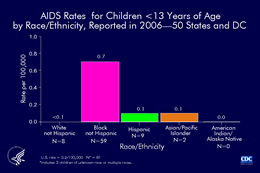
Slide 12
AIDS Rates for Children <13 Years of Age by Race/Ethnicity, Reported in 2006—50 States and DC.
PDF
File
 or
PPT
File or
PPT
File |
|
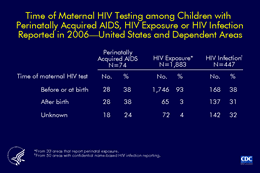
Slide 13
Time of Maternal HIV Testing among Children with Perinatally Acquired AIDS, HIV Exposed or HIV Infected Reported in 2006- United States
PDF
File
 or
PPT
File or
PPT
File |
|
|
|
|